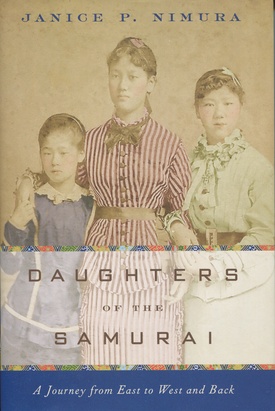Over the years I have been honored to be privy to the transnational stories both of Japanese women who lived in the United States and Japanese American women who resided in Japan. Some were students of mine at California State University, Fullerton (Mariko Yamashita, Chiaru Kawai, and Reiko Katabami), others I interacted with as peers through the Japanese American Council of the Orange County Historical and Cultural Foundation (Yasko Gamo, Masako Hanada, and Yukiko Sato), a few were Japanese American National Museum colleagues (Eriko Yamamoto and Yoko Nishimura), several more shared membership with me in the Japan Oral History Association (Kayoko Yoshida, Ann Sado, and Dale Sato), while one I befriended primarily via pilgrimages to California’s Manzanar and Tule Lake concentration camps (Sachiko Takita-Ishii). In reading and reflecting upon Janice P. Nimura’s extraordinary new book, Daughters of the Samurai, the tales all these Nikkei women related about their respective overseas experiences acquired enhanced resonance for me.
In fact, a major reason why Daughters of the Samurai transcends being simply a praiseworthy historical account of the transpacific journeys of her three Japanese female protagonists—Sutematsu Yamakawa (1860-1919), Shige Nagai (1861-1908), and Umeko Tsuda (1864-1929)—is because the present-day experiences of the author (an American daughter-in-law of a Japanese family who, with her husband, spent three post-collegiate years living and working in Japan) match up with those of her Meiji Era (1868-1912) subjects in Victorian America. This situation permits Nimura to empathize at a fundamental level with the far more challenging undertaking of Yamakawa, Nagai, and Tsuda when, in 1871, the Japanese government sent them (along with two other girls from samurai families, Tei Ueda and Ryo Yoshimasu, between the ages of six and fourteen) to the United States on a mission to not only live and study there, but also to immerse themselves in Western society and culture and thereafter return to Japan and share what they had learned, most specifically in terms of women’s education, to assist their country’s Westernization.
This three-part volume is blessed with the author’s deeply probing research into primary and secondary research and is expressed through a novelistic, even cinematic, narrative. Part I provides the larger Meiji Japan context in which the girls’ ten-year American sojourn, as a small part of the Iwakura Mission (consisting of about fifty rising male stars, average age of thirty-two, drawn from Japan’s new leadership), was conceived and enacted. Part II is set across the Pacific and it encompasses the mission’s rapturous and sometimes rambunctious American reception, especially in respect to the five girls, followed largely by the East Coast educational experience of the three youngest girls who completed their decade-long mission (the two fourteen-year-olds, Ueda and Yoshimura, chose to abandon their mission and return home to Japan). Part III treats the lives of Yamakawa, Nagai, and Tsuda during their post-American mission lives in their native Japan.
In some ways Daughters of the Samurai is a historical tragedy. For one thing, when Yamakawa, Nagai, and Tsuda left Japan for America in 1871, Japan was caught up in a Westernization fever, but by the time of their return home in the early 1880s, the pendulum had swung toward resisting Westernization and reconnecting with traditional Japanese ideas, values, and customs. Thus the girls discovered that their acquired fluency in Western language and manners was not embraced to the extent that they had anticipated. Secondly, while in the United States the command of Japanese language for Yamakawa and Nagai, had become rusty, while for Tsuda, it was now non-existent. On the other hand, to quote Nimura, “despite this dismaying shift, these young women still managed to make significant and lasting contributions to the progress of women’s education in Japan.”
Most notably, Umeko Tsuda, who returned to the United States in 1889 to secure her higher education at Bryn Mawr College, would later, in 1900, found one of the first private institutions of higher education for women in Japan. To date, Tsuda College has graduated more than 27,500 women, many of whom have taken an active role in one or another sector in Japanese society. As for Sutematsu Yamakawa, whose graduation from Vassar College made her the first Japanese woman to earn a bachelor’s degree anywhere, she married the emperor’s minister of war, Iwao Oyama, in 1883, and after 1884 became Countess Oyama. Being married to one of Japan’s most powerful men afforded her the opportunity to influence (from behind the scenes) the cause of women’s education. In the case of Shige Nagai, who in 1882 married Sotokichi Uriu, she became a music teacher at the Women’s Higher Normal School and, per Nimura, “juggled seven children and a teaching career generations before the phrase ‘working mother’ was coined.”
Notwithstanding these signal achievements, it is sobering to discover from one reviewer of Nimura’s book (James Hadfield) that Japan, a century after the closing of the Meiji Era, is currently “languishing at 104th place in the Global Gender Report.”
Because this cursory review only hints at the bountiful contents of Nimura’s brilliant book, readers are advised to view the remarkably illuminating C-Span conversation with Nimura on Daughters of the Samurai that another transpacific author, Marie Mutsuki Mockett, author of Where the Dead Pause, and the Japanese Say Goodbye (2015), had with her on May 12, 2015. In addition, let me note for Nichi Bei Weekly readers that one of Umeko Tsuda’s younger sisters was Yonako Tsuda Abiko (1880-1944), who after the death of her husband, Kyutaro Abiko (1865-1936), succeeded him as the publisher of the Nichibei Shimbun and maintained it as the leading Japanese vernacular newspaper in the U.S. until it was forced to close in 1942 owing to the World War II exclusion and incarceration of West Coast Americans of Japanese ancestry. For more information on Yonako Abiko, see Eriko Yamamoto’s essay about her on Discover Nikkei Website.
Daughters of the Samurai: A Journey from East to West and Back
By Janice P. Nimura
(New York: W. W. Norton, 2015)
*This article was originally published on Nichi Bei Weekly on January 1, 2016.
© 2016 Arthur A. Hansen / Nichi Bei Weekly








